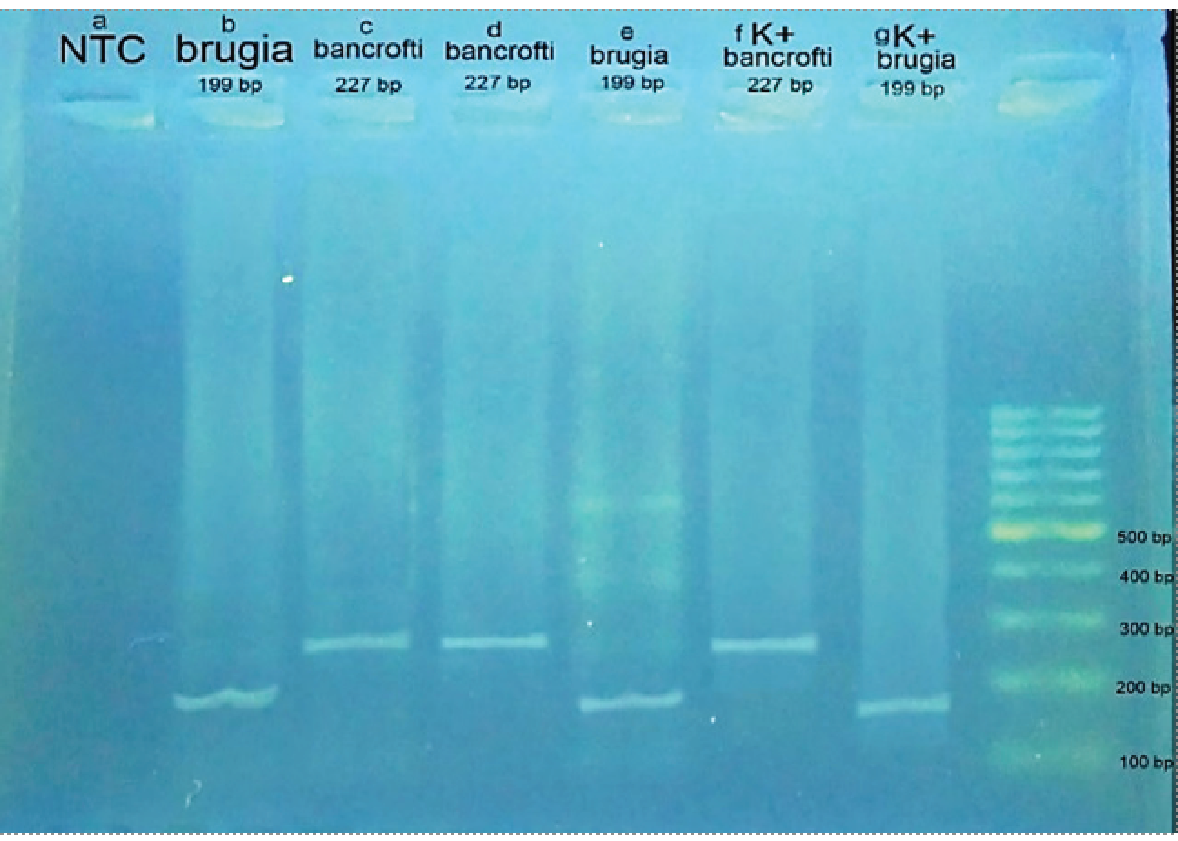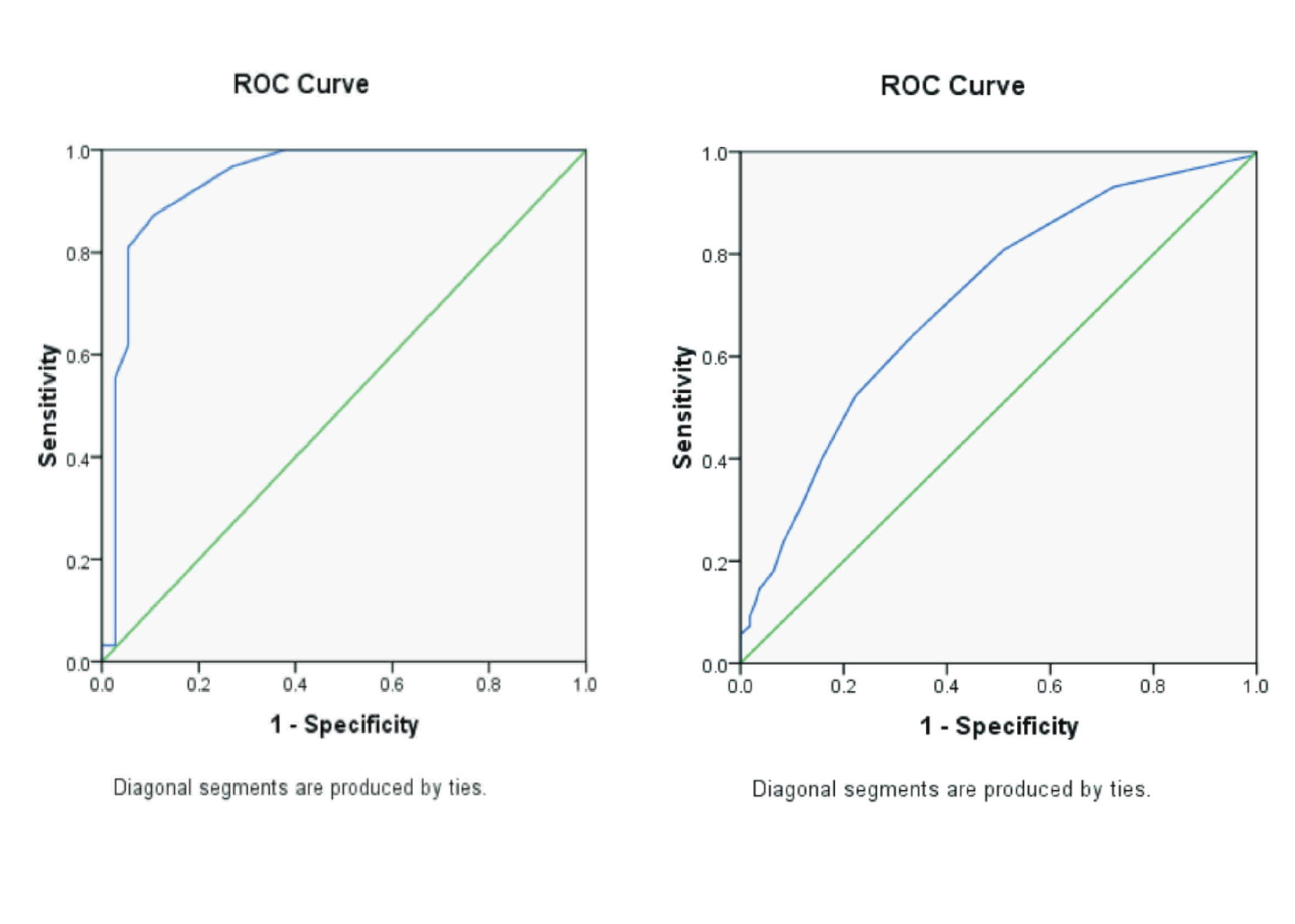IDENTIFICATION OF MICROFILARIAE USING CONVENTIONAL POLYMERASE CHAIN REACTION AND QPCR-HRM

Downloads
Background: The presence of filarial worms in the lymph nodes can result in acute symptoms, such as inflammation of the lymph nodes and ducts, particularly in the groin region. As part of the life cycle of filariasis, symptomatic or asymptomatic patients with microfilariae in their blood can transmit the disease via mosquito bites. The inspection of microfilariae that is currently being developed uses Polymerase Chain Reaction (PCR) to carry out a unique DNA search technique. Purpose: Identify the type of microfilaria present in filariasis patients using Quantitative PCR High- Resolution Melting (qPCR-HRM) and conventional PCR techniques. Method: This study involved the examination of 19 samples using the qPCR-HRM method. Subsequently, the results that were considered positive for microfilaria underwent further testing using conventional PCR. Result: The results of the examination using these two methods revealed the presence of Brugia malayi and Wuchereria bancrofti microfilariae with peak melting temperatures ranging from 78.2 – 78.7 °C and 80.8 – 81.2 °C, and fragment sizes of 199 bp and 227 bp, respectively. Conclusion: Based on the results of the identification from these two methods, it is evident that microfilariae of Brugia malayi and Wuchereria bancrofti can be detected using both conventional and qPCR-HRM methods.
Alhassan, A., Osei-Atweneboana, M.Y., Kyeremeh, K.F., Poole, C.B., Li, Z., Tettevi, E., Tanner, N.A., Carlow, C.K.S., 2016. Comparison of A New Visual Isothermal Nucleic Acid Amplification Test with PCR and Skin Snip Analysis for Diagnosis of Onchocerciasis in Humans. Mol Biochem Parasitol Vol. 210(1-2), Pp. 10-12.
Dieki, R., Nsi-Emvo, E., Akue, J.P., 2022. The Human Filaria Loa loa: Update on Diagnostics and Immune Response. Res Rep Trop Med Vol. 12, Pp. 41-54.
Ferlianti, R., 2012. Optimalisasi Real TIME PCR untuk Diagnosis Filariasis Bancrofti pada Sediaan Hapus Darah Tebal. YARSI medical Journal Vol. 20(1), Pp. 14-22.
Global Health, 2015. Life Cycle of Lymphatic Filariasis.
Ihsan, B.M., Sucipto, C.D., Khayan, K., 2021. Primary SLX Test using Real-Time PCR Based on High Resolution Melting (Hrm) on Microfilaria Examination. Journal of Vocational Health Studies Vol. 5(1), Pp. 26-30.
Lau, M.-J., Hoffmann, A.A., Endersby-Harshman, N.M., 2021. A Diagnostic Primer Pair to Distinguish between W Mel and W Albb Wolbachia Infections. PLOS ONE Vol, 16(9), Pp. e0257781.
Loymek, S., Phuakrod, A., Zaelai, K., Sripumkhai, W., Vongjaroensanti, P., Wongkamchai, S., 2021. Investigation on The Prevalence of Canine Microfilaremia in Thailand using A Novel Microfluidic Device in Combination with Real-Time PCR. Vet Sci Vol. 8(3), Pp. 39.
Majawati, E.S., 2007. Penggunaan Polymerase Chain Reaction(PCR) pada Diagnosis Filariasis. Jurnal Kedokteran Meditek Vol. 15(3), Pp. 1-8.
McPherson, B., Mayfield, H.J., McLure, A., Gass, K., Naseri, T., Thomsen, R., Williams, S.A., Pilotte, N., Kearns, T., Graves, P.M., Lau, C.L., 2022. Evaluating Molecular Xenomonitoring as a Tool for Lymphatic Filariasis Surveillance in Samoa, 2018-2019. Trop Med Infect Dis Vol. 7(8), Pp. 203.
Ministry of Health, 2015. Situasi Filariasis di Indonesia Tahun 2015.
Nirwan, M., Hadi, U.K., Soviana, S., Satrija, F., Setiyaningsih, S., 2022. Diversity, Domination and Behavior of Mosquitoes in Filariasis Endemic Area of Bogor District, West Java, Indonesia. Biodiversitas Journal of Biological Diversity Vol. 23(4), Pp. 2093-2100.
Nonsaithong, D., Yotmek, Supit, Yotmek, Somsri, Nochote, H., Wongkamchai, S., Roytrakul, S., Lek-Uthai, U., 2018. High Resolution Melting Real-Time PCR Detect and Identify Filarial Parasites in Domestic Cats. Asian Pacific Journal of Tropical Medicine Vol. 11(12), Pp. 682-687.
Phuakrod, A., Kusuwan, N., Sripumkhai, W., Pattamang, P., Wongkamchai, S., 2022. Semi-Automated Microfluidic Device Combined with a MiniPCR-Duplex Lateral Flow Dipstick for Screening and Visual Species Identification of Lymphatic Filariae. Micromachines (Basel) Vol. 13(2), Pp. 336.
Rahmah, N., Nurulhasanah, O., Norhayati, S., Zulkarnain, I., Norizan, M., 2010. Comparison of Conventional Versus Real-Time PCR Detection of Brugia Malayi DNA from Dried Blood Spots from School Children in A Low Endemic Area. Trop Biomed Vol. 27(1), Pp. 54-59.
Rao, Ramakrishna U, Atkinson, L.J., Ramzy, R.M.R., Helmy, H., Farid, H.A., Bockarie, M.J., Susapu, M., Laney, S.J., Williams, S.A., Weil, G.J., 2006. A Real-Time PCR-Based Assay for Detection of Wuchereria bancrofti DNA in Blood and Mosquitoes. The American Journal of Tropical Medicine and Hygiene Vol.74(5), Pp. 826–832.
Rao, Ramakrishna U., Weil, G.J., Fischer, K., Supali, T., Fischer, P., 2006. Detection of Brugia Parasite DNA in Human Blood by Real-Time PCR. J Clin Microbiol Vol. 44(11), Pp. 3887-3893.
Rojas, A., Rojas, D., Montenegro, V.M., Baneth, G., 2015. Detection of Dirofilaria Immitis and Other Arthropod-Borne Filarioids by An HRM Real-Time QPCR, Blood-Concentrating Techniques and A Serological Assay in Dogs from Costa Rica. Parasites & Vectors Vol. 8(1), Pp. 170.
Santoso, I.D., Sitohang, S., 2017. Pengaruh Motivasi, Kompensasi, Kesehatan dan Keselamatan Kerja Terhadap Kinerja Pegawai. JIRM Vol. 6(12), Pp. 1-15.
Scavo, N.A., Zecca, I.B., Sobotyk, C., Saleh, M.N., Lane, S.K., Olson, M.F., Hamer, S.A., Verocai, G.G., Hamer,G.L., 2022. High Prevalence of Canine Heartworm,Dirofilaria immitis, in Pet Dogs in South Texas,USA, with Evidence of Aedes Aegypti MosquitoesContributing to Transmission. Parasites & VectorsVol. 15(1), Pp. 407.
Suarez, J.A., Moreno, D., Pascale, J.M., Romero, L., Sosa, N., Ruiz, F., DeAntonio, R., Cumbrera, A., Franco-Paredes, C., González, J.A., 2022. Detection of Mansonella ozzardi in Peripheral Blood in Two Malaria-Endemic Areas in Panama. Therapeutic Advances in Infection Vol. 9, Pp. 20499361221122582.
Suryaningtyas, N.H., Santoso, S., 2015. Spesies Mikrofilaria pada Penderita Kronis Filariasis secara Mikroskopis dan Polymerase Chain Reaction (PCR) di Kabupaten Tanjung Jabung Timur. MPK Vol. 25(4), Pp. 20749.
Ta-Tang, T.-H., Febrer-Sendra, B., Berzosa, P., Rubio, J.M., Romay-Barja, M., Ncogo, P., Agudo, D., Herrador, Z., Fernández-Soto, P., Muro, A., Benito, A., 2022. Comparison of Three PCR-based Methods to Detect Loa and Mansonella Perstans in Long-Term Frozen Storage Dried Blood Spots. Trop Med Int Health Vol. 27(8), Pp. 686-695.
Thanchomnang, T., Intapan, P.M., Tantrawatpan, C., Lulitanond, V., Chungpivat, S., Taweethavonsawat, P., Kaewkong, W., Sanpool, O., Janwan, P., Choochote, W., Maleewong, W., 2013. Rapid Detection and Identification of Wuchereria Bancrofti, Brugia Malayi, B. Pahangi, and Dirofilaria Immitis in Mosquito Vectors and Blood Samples by High Resolution Melting Real-Time PCR. The Korean Journal of Parasitology Vol. 51(6), Pp. 645-650.
Wongkamchai, S., Mayoon, B., Wanachiwanawin, D., Foongladda, S., Boitano, J., Nochote, H., Loymak, S., 2014. Real-Time PCR with High-Resolution Melting Analysis for Diagnosis of Lymphatic Filariasis.
Zhong, M., McCarthy, J., Bierwert, L.A., Lizotte-Waniewski, M., Chanteau, S., 1996. A Real-Time PCR-based Assay for Detection of Wuchereria Bancrofti DNA in Blood and Mosquitoes. The American Society of Tropical Medicine and Hygiene Vol. 54(4), Pp.357-363.
Copyright (c) 2024 Journal of Vocational Health Studies

This work is licensed under a Creative Commons Attribution-NonCommercial-ShareAlike 4.0 International License.
- The authors agree to transfer the transfer copyright of the article to the Journal of Vocational Health Studies (JVHS) effective if and when the paper is accepted for publication.
- Legal formal aspect of journal publication accessibility refers to Creative Commons Attribution-NonCommercial-ShareAlike (CC BY-NC-SA), implies that publication can be used for non-commercial purposes in its original form.
- Every publications (printed/electronic) are open access for educational purposes, research, and library. Other that the aims mentioned above, editorial board is not responsible for copyright violation.
Journal of Vocational Health Studies is licensed under a Creative Commons Attribution-NonCommercial-ShareAlike 4.0 International License














































